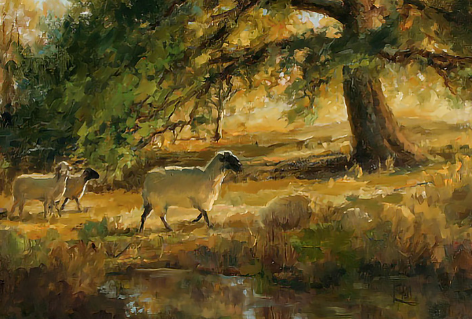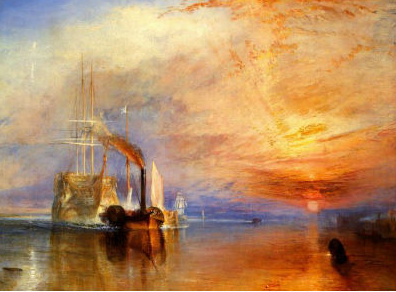Paintings can express a myriad of stories, emotions, and ideas that go beyond the surface, and learning how to accurately describe them is an art unto itself. From beginners to seasoned art enthusiasts, understanding the intricate details of how to describe a painting. Here, we demystify the art description techniques and guide you through the exciting journey of painting analysis.
Understanding the Key Elements in How to Describe a Painting

An in-depth painting description begins with an examination of the key elements that constitute a work of art. This includes color, line, shape, texture, space, and form. Each of these elements is a standalone language that conveys a particular aspect of the painting’s narrative.
Color speaks to the emotions, mood, and tone of the painting. Observe the dominant colors, their harmony, or contrast, and consider how they evoke specific sentiments. For instance, warm colors like reds and oranges might suggest passion, while cooler tones like blues and greens may evoke tranquility.
The use of lines is a defining factor in the visual structure of a painting. Are the lines straight, implying stability, or are they curved, suggesting movement and fluidity? Their direction, thickness, and length can further enrich your description.
Shapes and forms create a visual rhythm, bringing balance and unity to the painting. Examine how the artist uses geometric or organic shapes to enhance the visual impact of the work.
Texture refers to the way a painting’s surface looks or feels – it could be rough, smooth, or layered. Brushwork can also play a critical role in establishing texture.
Space conveys depth and perspective, creating a three-dimensional illusion in a two-dimensional medium. Notice the placement and overlapping of objects, the use of light and shadow, and the portrayal of horizon lines.
Delving Deeper: Analyzing Composition and Style

Beyond the basic elements, a painting’s composition, or the arrangement of its elements, is integral to its overall impact. Assess the balance of the composition, the focal point, and how your eyes move across the painting. Does the composition adhere to a rule, like the golden ratio, or is it asymmetrical, providing a sense of dynamism and tension?
The artist’s style is another vital aspect of your art description. You could be looking at a Renaissance masterpiece, a piece of Impressionism, or an abstract work. Each style has distinct characteristics that influence the painting’s presentation and underlying meaning.
Decoding Symbolism and Metaphors in Art

The symbolism in paintings can transform a seemingly straightforward scene into a complex narrative. Identifying and interpreting symbols and metaphors offer insight into the artist’s mind and the cultural or historical context of the artwork.
For instance, a raven might represent ominous foreboding, a fruit might symbolize abundance, or a particular pose might denote a religious reference. Remember, symbolic interpretation can vary widely based on different cultures and historical periods.
How to Describe a Painting into Words: Art Description Techniques
When describing a painting, it’s essential to balance objectivity with subjectivity. Begin by stating the factual details: the artist’s name, the title of the work, its medium, size, and date. This provides the context for the painting.
Next, observe and articulate the visual elements and compositional features. Use vivid and precise art critique adjectives. Instead of simply saying a painting is ‘beautiful’, try words like ‘luminous’, ‘intricate’, or ‘provocative’ to capture its essence.
Remember, it’s not merely about listing the painting’s features. Aim to weave a cohesive narrative that reflects the artwork’s visual and emotive impact, its symbolic meanings, and its cultural and historical relevance.
Considering Emotions and Intent in Artwork

One aspect that truly makes a painting come alive is the emotions it communicates. This is a deeply subjective part of art description and can vary greatly from one observer to another. However, recognizing and articulating these emotions is a powerful way to connect with the artwork on a personal level.
Consider the feelings evoked as you take in the painting. Does it create a sense of joy, sadness, fear, or serenity? The colors, lines, composition, and subject matter all play a part in stirring these emotions. For instance, an image of a tranquil lake bathed in soft, warm hues might evoke a sense of calm and peace, while a turbulent sea under a stormy sky might evoke feelings of fear or unease.
Additionally, consider the artist’s likely intention. Why did the artist create this piece, and what message or emotion were they hoping to convey? While the artist’s intent can be challenging to determine, any available information about the artist, their life, and the era in which they worked can provide valuable clues.
The Role of Historical and Cultural Context

Historical and cultural contexts play a crucial role in both the creation and interpretation of a painting. When describing a painting, understanding the time and place it was created can shed light on its themes, symbols, and techniques.
Consider the broader socio-political environment of the era. Was the painting created during a time of war, social unrest, or significant cultural shifts? These influences often find their way into art, affecting its content, style, and symbolism.
The cultural context, including the artist’s cultural background and the traditions they were part of, also shapes a painting’s interpretation. For instance, symbolism and color usage can have different meanings across cultures. A color or object that signifies good fortune in one culture might represent something entirely different in another.
Describing Abstract and Non-Representational Art
Abstract and non-representational art can be particularly challenging to describe due to their departure from traditional, recognizable forms. In these types of art, the focus often shifts from representing physical reality to exploring the relationships between colors, shapes, and textures.
When describing abstract art, it’s beneficial to let go of the need to find recognisable shapes or objects. Instead, focus on the interplay of the visual elements and how they create a dynamic visual experience. Note the feelings and ideas these compositions evoke in you.
Abstract art often invites personal interpretation. It’s entirely acceptable for your description to be highly personal and subjective, reflecting your unique interaction with the artwork.
Also Read: Whose Responsibility is it to Lead and Coach the Organization in its Scrum Adoption?
Concluding Remarks
Describing a painting is a skill that deepens and enriches our experience of art. It not only allows us to engage with the painting more profoundly but also enhances our understanding of the world around us and our place within it.
This process of observation, analysis, and interpretation nurtures our capacity for critical thinking, empathy, and self-reflection. It helps us to see more, feel more, and connect more deeply with the power and beauty of art.
So, the next time you encounter a painting, take a moment to pause, reflect, and describe. Allow yourself to become immersed in its colors, forms, and textures, its emotions and stories, its historical and cultural contexts. Remember, there is no ‘right’ or ‘wrong’ way to describe a painting. It is, above all, a personal journey of discovery and appreciation, one brushstroke at a time. As we wrap up, we trust that this comprehensive exploration of “How to Describe a Painting?” has equipped you with the knowledge and tools necessary to navigate its complexities with confidence.

Aretha Davis, the wordsmith extraordinaire, weaves enchanting tales with her pen and keyboard. A renowned blogger and writer, her captivating prose transports readers to realms unknown. Join her literary journey and be swept away by the magic of her words.
